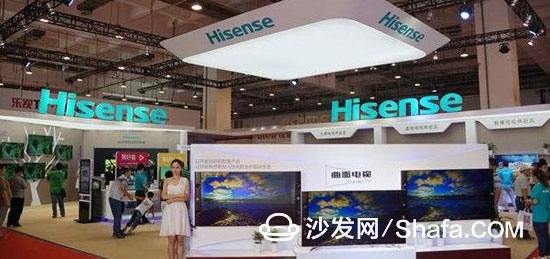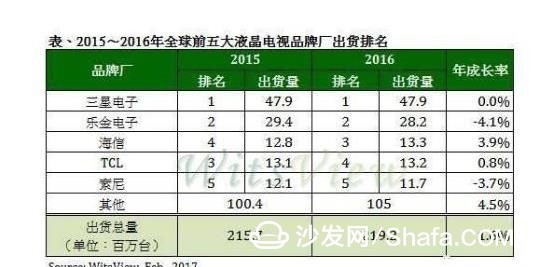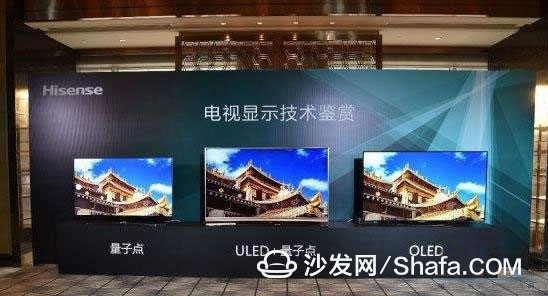Telephone Cable,Telephone Extension Cable, Utp Rj11 cable, Telephone Patch Cord, communication cable, transmission cable Telephone Cable,Telephone Extension Cable, Utp Rj11 cable, Telephone Patch Cord, communication cable, transmission cable Ningbo HanCheng(HC) Electronic Co.,Ltd , https://www.hcwires.com

However, such goodness does not benefit all brands. According to WitsView data, Samsung, LG, and Sony did not seize the opportunity: In 2016, Samsung's color TV shipments remained at a stagnant state in 2015; LG TV shipments fell 4.1%, which is the global color TV 5 The strongest decline in the brand; Sony TV is also in a recession, a year-on-year decline of 3.7% in 2016.
Of the top 5 global TV companies, only China's two strongest local companies, Hisense and TCL, achieved positive growth. Nail Technology noted that although TCL has increased, it has only risen 0.8%, while Hisense has significantly increased by 3.9%. This means that only Hisense has achieved significant growth among the top five global companies.
The success of Hisense and TCL reflects the rise of the local color TV brands in China. Industry experts pointed out that compared with foreign brands, China's color TV industry has two major advantages:
First, from the perspective of the supply chain, China has the most competitive flat panel display industry chain in the world. At present, the mainland has 8 mass production lines of 8.5 generation, panel production ranks third, accounting for 31% of global production. There are currently eight high-generation lines under construction. It is expected that the mainland will become the world's largest semiconductor display industry base in 2019.
Second, from the perspective of market demand, China's domestic demand still has potential, large-size products and new technology products have become mainstream, and product upgrades have accelerated the replacement of television products, and the market size of the color TV industry will continue to grow.
It can be foreseen that there are two major advantages of the industry chain and the market, and the local color TV brands in China will continue to grow strongly.
Under the big screen trend, the high-end counterattacks the Chinese color TV industry to fully catch up with foreign brands, and Samsung is an opponent that could not pass the past. In Nail Technology's opinion, although Samsung TV is currently in a stagnant state of development, it has held the world's number one throne for many years and its strength cannot be ignored. Then, is it possible that Hisense, which is growing rapidly, will be able to surpass Samsung? 
According to data from Ikon, Hisense’s high-end large screen market share of 55 inches or above has reached 17.63%, surpassing Samsung to achieve summit, and Hisense’s laser TV sales in over 85-inch large screen market accounted for more than 40%, making it a super-large screen. The preferred product of TV.
Hisense's efforts to produce high-end large-screen market are not without basis. In 2017, the proportion of 55-inch or larger flat panels is expected to reach 36.3%, and the market share will increase by 5.4%, becoming the only growth segment in the market. In the next five years, the compound growth rate of the ultra-large screen over 85 inches will reach 110%, and the era of large-screen television consumption has already arrived.
Xiao Bian believes that taking the lead in breaking through the high-end big screen market is of great significance to China's local TV brands:
On the one hand, breakthroughs from high-end big screens mean that better display technologies are needed to support them. This will force color TV companies to innovate display technologies with greater intensity, so that they will not only achieve surpassing in the market, but will also surpass the core technology.
On the other hand, breakthroughs from high-end big screens can get rid of the quagmire of low-quality, homogenous competition, achieve higher product value and user value, help build a new business model of soft and hard, and promote industrial transformation and upgrading.
Therefore, going beyond Samsung is not a simple tactical goal, let alone a frivolous slogan, but a strategically important event that relates product innovation, enterprise development, and industrial upgrading. The high-end counterattack under the big screen trend shows the rise of national brands, and it also reflects the rise of great countries' wisdom creation.
Technology is Wang Yong's retrospection of the rise of Japanese and Korean brands. The core technology is the key to his dominant market. In the process of retrogression of local color TV brands, autonomous technology will also play a key role. Without core technology, there will be no market dominance, and it can only be “down on the nose†in the downstream of the industrial value chain. In this sense, the technology of the color TV industry is not out of date. 
The next-generation display technology of the color TV industry has formed three camps: laser television, Quantum-dot TV and OLED TV. The three major technology Chinese companies have different degrees of layout.
LCD TVs will follow the development direction of the ultimate quantum dots and integrate new technologies such as ULED, 8K, HDR and OLED technology. It can be foreseen that LCD TVs will remain mainstream products in the market for the next three years. Hisense has always been at the forefront of the evolution of liquid crystal display technology through its self-developed ULED technology and the integration of new quantum dots and other technologies. Compared with LCD TVs of the same size, OLED prices are up to 3 times, and the technology maturity is not enough. The main technology is in the hands of Korean companies, and it is relatively lack of competitive advantage.
Compared with traditional TVs, laser televisions are more realistic and eye-safe. Compared with LCD TVs of the same size, the price is lower, and it is expected to develop rapidly in the ultra-large screen market. It is commendable that Hisense fully mastered the core technology in the field of laser display technology and has achieved complete autonomous operations from R&D, design, and manufacturing to complete machines.
In addition to the display technology, in the upstream segment, Chinese mainland panel companies rushed forward under the guidance of policies, capital, and market troika. In 2016, the shipment of panel companies in mainland China has exceeded 30%, and it is expected to maintain growth in 2017. The accelerating localization of polarizers, chips, glass and other raw materials has also enhanced the supporting capabilities of the localization industry.
On the basis of mastering the core technology, relying on the two major advantages of the industrial chain and the market, it is the first breakthrough in the high-end large-screen market. This is the development road map for Chinese color TV companies. It can be foreseen that the “Japan-Korea era†of the global color TV industry will eventually pass. The industry will surely usher in a new benchmarking company and lead the brand-new changes in products and industries.
Who will become the new benchmark for the global color TV industry after Samsung, Sony and LG?
New technologies are emerging, new models are surging, and new markets are on the rise...There is no doubt that the current global color TV industry is undergoing a new round of changes. During this period of change, foreign brands such as Samsung, Sony, and LG gradually lost their vitality, while the Chinese local color TV brands represented by Hisense have achieved a strong development. According to the latest data from WitsView, a well-known data research company, among the top five global TV manufacturers in 2016, Hisense ranked among the top three and became the only brand among Samsung, LG, Hisense, TCL, and Sony to achieve significant growth. In stark contrast to this, Samsung is in a state of stagnation and Sony and LG are in a major recession. After the Japanese and South Korean brands fall out of fashion, who will become the new benchmark for the global color TV industry? Quality technology is one of the most important technologies in the color TV industry. Although television has been closely integrated with the Internet, as the family-side audio-visual products, the picture quality is still the first element of concern for users to buy television, so the display technology competition will remain the main theme of competition.
More important than ranking is growth
If you look at the rankings, Samsung, LG, Sony, these three giants are still a major force in the color TV industry. In Xiao Bian's opinion, however, the industry seats are not static, and all brands must be aware that if they go against the tide, they will not retreat. Therefore, dynamic trends are more important than simple rankings. 2016 global pre-color TV brand shipment ranking
The TV industry's pick-up in 2016 is a positive for color TV brands. WitsView released 2016 global color TV sales data report shows that last year global LCD TV shipments was 219 million units, a slight increase compared to 2015, with a growth rate of 1.6%. The global LCD TVs rebound in 2016 was mainly due to the dramatic pick-up in the color TV market in North America and the increase in the Chinese real estate market, which has led to the popularity of large-size TVs. Hisense Laser TV
The alternation of the old and new kings is not an overnight one, and a single breakthrough is the beginning of a comprehensive transcendence. From the current perspective, Hisense has already achieved suppression of Samsung in the high-end large-screen market. Smart TV/box information can focus on smart TV information network sofa butler (http://), China's influential TV box and smart TV website, providing information, communication, TV boxes, smart TVs, smart TV software, etc. Answering questions.